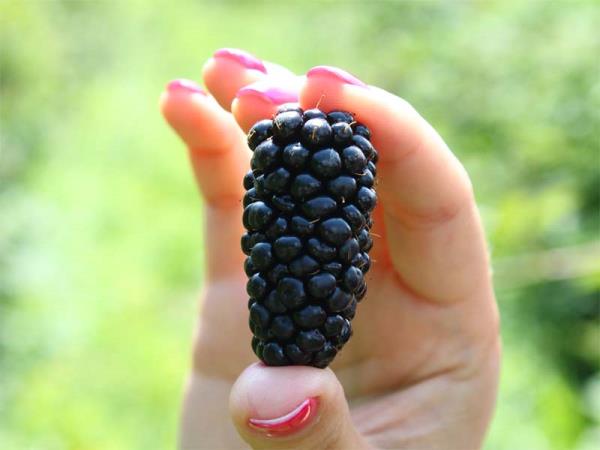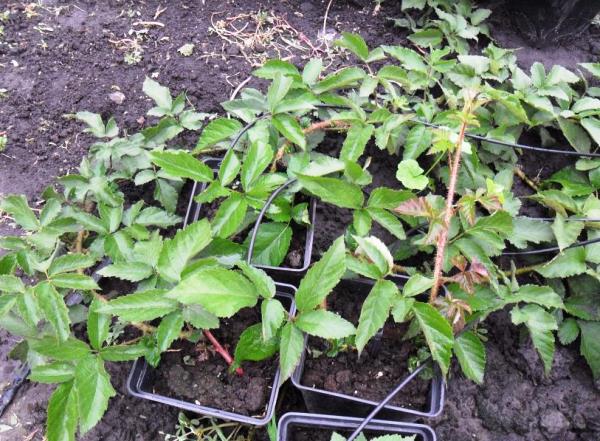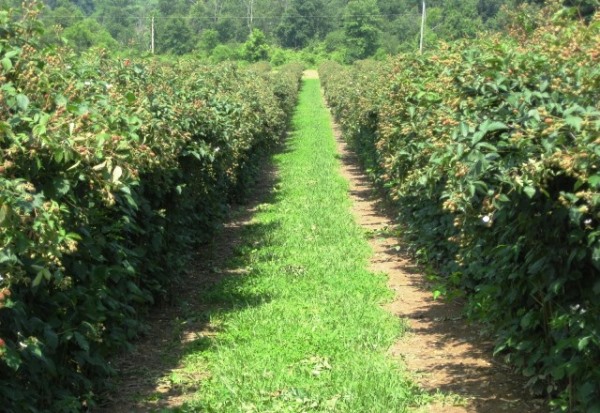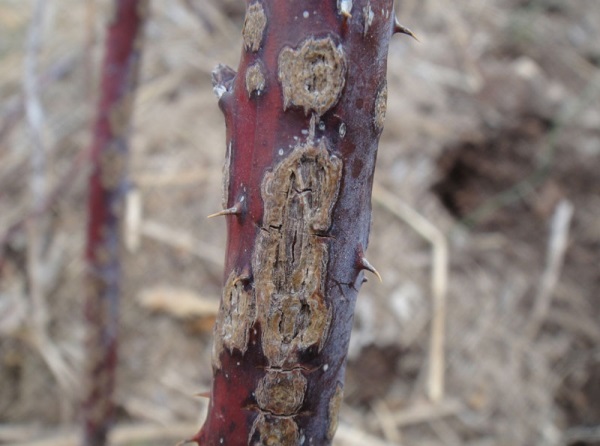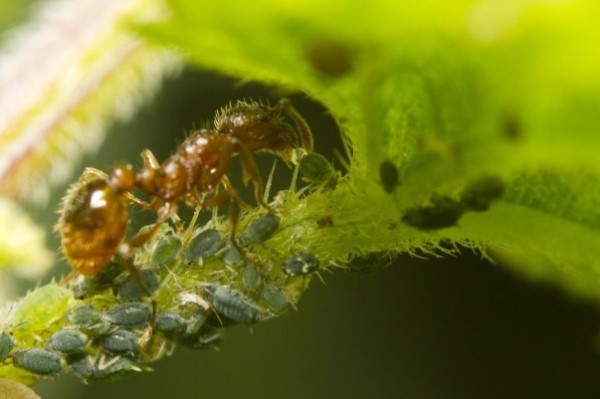A promising hybrid of blackberries - Karaka Black
Content
Description and characteristics of the variety
"Karaka Black" ("Karaka Black") is a dewdrop, a creeping variety, although among its parents there was a pronounced upright blackberry variety. Its shoots grow up to 3 meters, and according to some reviews even up to 5 meters, usually they are not shortened in order to increase the number of fruit branches. The fact is that "Karaka Black" does not need this, its internodes are much shorter than other varieties of dewberry, there are a lot of fruit twigs on each shoot, so that the whole second half of the summer the bush looks very picturesque: it is hung with clusters of large berries that have ripened glossy -black and immature reds.
The official description of the variety notes the external similarity of the berries with very large mulberries. Indeed, simply huge for a blackberry, the berries of this variety reach 4–5 cm in length, they taper downwards and bend barely noticeably on one side. Average weight 10 g, individual berries grow up to 15-17 g.
The first year of fruiting gives a small harvest, but in the third - fourth year of life, one bush gives 12-15 kg of very useful sweet and sour fruits per summer. The taste is officially called dessert. At the stage of technical maturity, when the entire berry has already turned black (it may have a purple tint) and it can be easily removed from the branch without deformation, the sourness is felt very clearly. After a day or two, it will practically disappear, giving way to sweetness, and the overripe berry that falls to the ground is already practically tasteless.
Fruiting of the "Karaka Black" variety begins early, so in the southern regions the first blackberries are harvested from mid-June (in the middle lane - from July), and it lasts up to 2 months. At the end of August, when the main crop from the tops of the shoots has already been harvested, flowers and fruits of varying degrees of maturity can be observed on the lower fruit branches. Perhaps such a prolonged period of fruiting makes the industrial cultivation of this variety inconvenient, but for households it is even convenient - you can eat and make preparations during the period of the greatest ripening of the fruits, and then feast on healthy berries until autumn, when they are no longer ripe in such large batches.
This variety does not differ in particular frost resistance, therefore, in the fall, the lashes are removed from the trellises and laid in a prepared ditch, covered for the winter. They grow long, but braiding on a wire and then unbraiding the branches can be done without hassle - they are strong and flexible. But this work will not give pleasure because of the thorns. The thorns of "Karak Black" are not very large, at first they are just small sharp thorns, and then they become harder, and it is unpleasant to work with the plant precisely because of them. Be sure to use thick gloves.
This variety of blackberries propagates, as befits a dewdrop, by layering. Moreover, if you do not follow the tip of the shoot, let it touch the ground, then it takes root very quickly.So it is very easy to propagate this variety.
All cuttings turn into healthy seedlings that perfectly retain the characteristics of the variety. This created some informational and commercial confusion. Saplings of a new variety are always quite expensive, but you can find offers to buy saplings of a completely new variety called "Kara Black". They are offered to buy for planting and are characterized as the offspring of the large-fruited variety "Karaka Black". The description of the variety and the care of the seedlings are the same, and the price is slightly lower than what is asked for licensed seedlings of the New Zealand variety. So the blackberry "Kara", variety "Kara Black" is the same New Zealand "Karaka Black".
Video "Blackberry variety Karaka Black"
This video will give you an idea of the New Zealand blackberry variety and the peculiarities of its cultivation.
Growing features
Kara Black prefers nutritious loams without stagnant water, the soil must be prepared for planting seedlings, or fertilizer is applied directly to the pit. The place needs to be chosen open so that the plant receives maximum sunlight. It is important to note that different growing conditions have a significant impact on taste. So the lack of sun or soil, poor in potassium and magnesium, determines the dominant acidity of the berries. If you want to get a harvest of sweet berries with a complex dessert taste, in which tasters note either apple or pineapple notes, and the smell and aftertaste resemble raspberries, then try to find a suitable place, fill the soil well with fertilizers before planting. If necessary, blackberries are fertilized in spring and summer, "Kara" is no exception.
There are no features of care that would distinguish this variety from its counterparts. If in the summer too light, almost yellow leaves appeared on the bush, you should not worry, this does not indicate a lack of iron, just a property of the variety, a little later the leaves will acquire the usual color.
For industrial cultivation, the bushes are planted at a distance of 1.5–2 m in a row, and 3 m are left between the rows. In summer cottages and small farms, it is recommended to leave at least 3 meters between plants, which are necessary for full growth and fruiting.
Care
In a warm southern climate, "Kara Black" seedlings can be planted in the fall, and in the middle lane and to the north, they are planted in the spring, so that there is no threat of freezing of immature plants. Then they are watered, mulched, fertilized, tied up and cut off - the care is the same as the blackberry requires. Mulch made from humus, compost or peat not only retains moisture, but also constantly feeds the bush with each watering. Even just cut grass perfectly plays the role of mulch, it saves the soil from overheating and excess moisture evaporation, does not allow weeds to grow.
From the beginning of flowering, mineral fertilizers are applied, potassium is definitely needed. Blackberries respond well to nitroammophos. Later, foliar dressing can be carried out, but it all depends on the condition of the soil and the amount of fertilizers applied in the spring.
It is necessary to loosen the soil around the shoots carefully, the "Kara Black" variety does not give root growth (which greatly facilitates its care), but if the roots are damaged when loosening too deep, then root suckers will form, which will then have to be disposed of anyway.
Caring for mildew is pruning and tying fast growing lashes. This variety does not need to be pruned in summer, it already has a lot of fruit branches. On each of them, however, slightly fewer berries are formed compared to other varieties, but this can be explained by their size. Are there many varieties with such large fruits?
But the shoots are tied up on trellises with a height of about 2 m. Usually the racks are made 1.70 m, 3 rows of wire are pulled on them, on which the shoots are wound.You need to make sure that they do not fall to the ground, otherwise you will get random thickets of prickly blackberries, even large tasty berries will not please if you have to deal with its prickly lashes.
In the fall, the lashes are carefully untwisted, laid out on the ground, cut off, twisted and hidden for the winter. It is imperative to work with gloves, but care is facilitated by the flexibility of the whips themselves. The next year, 7–9 healthy annual shoots are left, the fruiting shoots of this year are completely removed.
Diseases and pests
The variety "Karaka (Kara) Black" has an average resistance to diseases.
With insufficient care, a weakened plant can be affected by fungal diseases such as anthracnose, botrytis (better known as gray rot), powdery mildew.
There are special chemicals that can help defeat pathogens, but you can lose crops and greatly weaken the plant.
It is much better to avoid diseases. To do this, you need to take preventive measures that are designed to destroy pathogens. These are all the activities that the owner conducts in his garden: weeding, harvesting leaves and weeds, digging row spacings. In no case should you leave leaves or grass near the bushes - pathogens of most diseases winter among them. And plants - blackberries and raspberries, since they have the same enemies and diseases, you need to carefully examine: if you notice affected shoots, leaves or flowers, you need to immediately cut off the affected parts and destroy, and treat the whole plant with infusions of tobacco, garlic, ash with liquid soap ...
If the bush has enough nutrients, it grows healthy, and plant debris does not lie around it, then practically nothing threatens it. Good care is the key to plant health in the garden, and blackberries are no exception. It is also necessary to monitor the density of the bush, many diseases, especially fungal ones, most often occur with high humidity and shade.
Of the pests, the plant can most often suffer from raspberry shoot aphids, these insects can occupy young shoots.
In autumn and spring, plants need to be inspected, if aphid eggs are seen, the branches must be ruthlessly destroyed.
Once every few years, raspberries and blackberries are advised to process with nitrafen. Here, again, tobacco or ash infusion will come to the rescue.
The possibility of disease or damage by pests always exists, but these troubles are not at all necessary. With good care, healthy plants feel great, give their owners only tasty fruits, and not the hassle of healing or rescue.
Video "Shelter of the garden blackberry"
In this video, the author shares his experience of hiding a garden blackberry for the winter.


